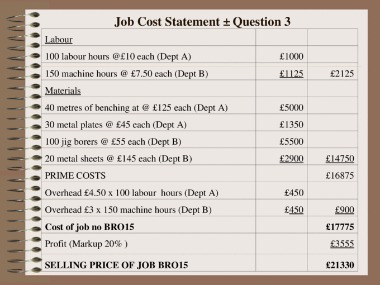He also discovers that consumer doggy dental business competitors sell their toothbrushes at $8. Bert will also sell his product at the market price of $8; with that, Bert tries to decide what quantity to produce. The graphs shown in this section are samples; each business will have different variables and parameters that change the steepness and shape of the graph. Fixed costs are business costs that occur regardless of output level.
- For example, rent paid for a building will be the same regardless of the number of widgets produced within that building.
- You’ll need to sell 600 cups of coffee every month if you want your business to be profitable.
- If a company makes zero sales for a period of time, then total variable costs will also be zero.
- These costs remain the same for a considerable period as they are usually related to the fixed assets of a firm.
- Raw materials, labour costs of temporary workers, and packaging are examples of variable costs, while rent, salaries, and property taxes are examples of fixed costs.
- If the business produces 200 units, its variable cost would be $1,000.
This is the clear distinction between these two different types of costs. Variable costs are expenses that change as production increases or decreases. If a company produces more products or services, then variable costs will rise. If a company scales back production, then variable costs will drop. These businesses can easily cover their small amounts of fixed costs.
The difference between fixed and variable costs
This can be important in determining the price and value of the product. Despite economies of scale occurring as output increases, eventually, the opposite will happen. Past a point, diseconomies of scale begin to increase production costs. When production grows too large, it can lead to a loss of efficiency because it becomes hard to manage everything. For example, a business rents a building for a fixed cost of $50,000 per month for five years. The rent will stay the same every month, regardless of the business’s profit or losses.
As variable costs change directly in relation to the output of a business, so when there is no output, there are no variable costs. A good example of variable costs is the operational expenses that increase or decrease based on the business activity. If a business grows, so will its expenses such as utility bills for electricity, gas, or water. Knowing the difference between expenses and revenue is the key to understanding the profitability of your business. An understanding of the fixed and variable expenses can be used to identify economies of scale.
Fixed Cost vs Variable Cost
A fixed cost is a cost that does not increase or decrease in conjunction with any activities. Thus, a business will incur fixed costs even when there is no business activity. Examples of fixed costs are rent, insurance, depreciation, salaries, and utilities. Examples of variable costs include the cost of raw materials, labor costs, and sales commissions. The best way to understand fixed and variable costs is to view an example, so see the example below of a business’s production costs. Total cost tends to decrease at first and then increase later because of how fixed and variable costs react differently to changes in output.

Each taco costs $3 to make when you consider what you spend on taco meat, shells, and vegetables. There are many techniques for making your business more profitable. For example, there are some handy formulas every business owner https://kelleysbookkeeping.com/product-costs-versus-period-costs/ should know to figure out monthly revenue and expenses. Knowing the difference between fixed cost and variable cost will allow producers to minimize both costs and set up their production to have the most efficient outcomes.
What Is Variable and Fixed Cost in Accounting?
It can also give entrepreneurs, who are considering buying a small business, information about projected profits. The equation can help them calculate the number of units and the dollar volume that would be needed to make a profit and decide whether these numbers seem credible. Another example is a retailer that doubles its typical order to prepare for a holiday rush. Larger purchase orders may also result in increased overtime pay for employees.

A business can also have discretionary expenses such as gifts, vacations, and entertainment costs. These are desirable, but you can choose whether to have them or not. Our cash discount program passes the cost of acceptance, in most cases 3.99%, back to customers who choose to pay with a credit card. Integrate our services with yours to solidify your place as a trusted advisor for your commercial banking customers. Continuously review income statements, balance sheets, and other financial statements to make the necessary adjustments and ensure that you do what’s best for your company at all times.
Fixed Costs Explained
A small cupcake bakery has a fixed monthly rent of $1,000 for its storefront, as well as a fixed salary expense of $3,000 for its full-time baker. These are fixed costs because they do not change regardless of how many cupcakes the bakery produces. Based on variability, the costs has been classified into three categories; they are fixed, variable and semi-variable. Fixed costs, as its name suggests, are fixed in total i.e. irrespective of the number of output produced.
Similarly, if the business produces 10,000 mugs, the cost of renting the machine stays the same. Keep in mind that fixed costs may not be consistent in the long run. Variable The Difference Between Fixed Cost, Total Fixed Cost, And Variable Cost costs can be challenging to manage as they can vary from month to month, increase or decrease quickly, and have a more direct impact on profit than fixed costs.
The graph below demonstrates linear variable costs, which is not always the case. Average fixed will trend downwards as fixed costs are constant, so as output increases, average fixed costs will decrease dramatically. A business with an overhead of 100 million may seem like a steep fixed cost.
- Variable costs increase when a firm goes from producing 1 to 1000 units.
- Variable costs are of the nature of frequent change depending on the nature of the costs.
- Once fixed costs have been paid for, all additional sales typically have quite high margins.
- The equation can help them calculate the number of units and the dollar volume that would be needed to make a profit and decide whether these numbers seem credible.
- Fixed costs are those that aren’t a function of the production level and are constant (such as rent payments).
In contrast, variable costs do change depending on production volume. For example, the cost of materials that go into producing the widgets will rise as the number of widgets produced increases. Variable costs are any expenses that change based on how much a company produces and sells.
